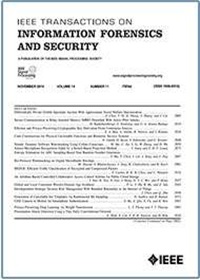An SNR-Aware Feature Reconstruction Method in Radio Frequency Fingerprint Identification
IF 8
1区 计算机科学
Q1 COMPUTER SCIENCE, THEORY & METHODS
IEEE Transactions on Information Forensics and Security
Pub Date : 2025-07-24
DOI:10.1109/TIFS.2025.3592567
引用次数: 0
Abstract
The radio frequency fingerprint (RFF) has gained significant traction in the identification of wireless Internet of Things (IoT) devices. However, RFFs extracted from wireless signals are inherently susceptible to noise, particularly for narrowband signals. Furthermore, the noisy domain adaptation (NDA) problem presents a substantial challenge for RFF identification due to the variable noise interference across different noisy domains. To address this, the squared cross power spectral density (SCPSD) as new device RFFs is derived theoretically as a function of signal-to-noise ratio (SNR). Combined with the proposed high-precision SNR estimation algorithm, SCPSDs under low SNR can be reconstructed to the same feature distribution as those under high SNR. Because of the interpretability, ten samples under high SNR from each device under test (DUT) and a shallow convolutional neural network (CNN) are trained for experimental evaluation on the NDA problem. Tested on 60 off-the-shelf ZigBee DUTs, the improvement of identification accuracy is around 26% for SNR between 5 dB and 10 dB, and the overall improvement is more than 20% compared to the baseline. It outperforms the three other compared methods across all testing SNR and is highly practical.射频指纹识别中感知信噪比的特征重构方法
射频指纹(RFF)在无线物联网(IoT)设备的识别中获得了显著的吸引力。然而,从无线信号中提取的rff本质上容易受到噪声的影响,特别是对于窄带信号。此外,由于不同噪声域的噪声干扰是可变的,噪声域自适应(NDA)问题给RFF识别带来了很大的挑战。为了解决这个问题,从理论上推导了作为新器件rff的平方交叉功率谱密度(SCPSD)作为信噪比(SNR)的函数。结合本文提出的高精度信噪比估计算法,可以将低信噪比下的scpsd重构为与高信噪比下相同的特征分布。由于可解释性,我们从每个被测设备(DUT)中选取10个高信噪比的样本和一个浅卷积神经网络(CNN)进行NDA问题的实验评估。在60个现成的ZigBee dut上进行测试,在5 dB到10 dB之间的信噪比下,识别精度提高了约26%,与基线相比,总体提高了20%以上。它在所有测试信噪比中都优于其他三种比较方法,并且非常实用。
本文章由计算机程序翻译,如有差异,请以英文原文为准。
求助全文
约1分钟内获得全文
求助全文
来源期刊

IEEE Transactions on Information Forensics and Security
工程技术-工程:电子与电气
CiteScore
14.40
自引率
7.40%
发文量
234
审稿时长
6.5 months
期刊介绍:
The IEEE Transactions on Information Forensics and Security covers the sciences, technologies, and applications relating to information forensics, information security, biometrics, surveillance and systems applications that incorporate these features
 求助内容:
求助内容: 应助结果提醒方式:
应助结果提醒方式:


